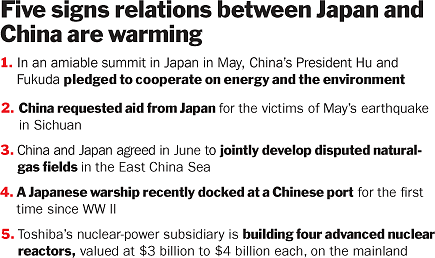
An 11-story building in Beijing is one of the few places in China where you'll hear people speak fondly of Japan. Inside are the offices of the Sino-Japan Friendship Center for Environmental Protection, where experts study how Japan became one of the world's most energy-efficient countries, with the aim of applying those lessons and methods to China. The center, which monitors pollution levels and researches environmental technologies, is partially funded by the Japanese government. Even the office building was built with a $100 million grant from Tokyo. "Japan, on an international level, is a responsible country," says the center's vice director, Xia Guang. "We recognize that Japan's work promoting environmental protection in China has real seriousness and we thank the government and people of Japan."
It's hard to fathom China thanking Japan for anything. The relationship between the two Asian giants has been strained for decades and occasionally erupts into open hostility. Japan perceives China as a rising economic competitor and a rival for political influence in Asia. Many Chinese still believe Japan has never properly repented for the sins committed during its brutal invasion during the 1930s and '40s, during which the notorious Rape of Nanjing occurred. Only three years ago, that resentment exploded into anti-Japan demonstrations in several Chinese cities.
Yet on the issue of the environment, the two nations have strong reasons to heal old wounds. China's wasteful use of energy and escalating environmental degradation threaten the sustainability of the country's economic boom. Japan, one of the most environmentally conscious countries in the industrialized world, is brimming with the know-how that can help ease China's problems. China badly requires Japanese technology in everything from advanced nuclear reactors to clean steel mills to hybrid cars; Japan has every incentive to sell that technology to China to generate new business for its otherwise sluggish economy. That's why the environment was a top topic of discussion when China's President Hu Jintao and Japan's Prime Minister Yasuo Fukuda met in Tokyo in May. In a joint statement, they pledged to place "particular priority" on working together in green technologies. In a speech before Japan's chief business association, Nippon Keidanren, Hu said he hoped the two countries would make environmental protection "the new highlight of our economic cooperation."
Making Hu's words reality is crucial for the global battle against climate change, an issue that will feature prominently at this month's Group of Eight (G-8) summit in Toyako, Japan. Starting July 7, the leaders of the G-8 industrialized countries — Canada, France, Germany, Italy, Japan, Russia, the U.K. and the U.S. — hope to make headway on an agreement to reduce greenhouse-gas emissions that would succeed the Kyoto Protocol, which expires in 2012. But any attempt to halt global warming must include a reduction in the rampant growth of greenhouse-gas emissions from the developing world — and from China in particular. As the country's economy roars, the more carbon dioxide pours out of all its new Buicks, cement factories and coal-fired power plants. Last year, China overtook the U.S. as the world's No. 1 producer of greenhouse gases.
Not only does Japan have the technology and money to help China, India and the rest of emerging Asia reduce emissions, it also has the political will to share it. The government sees assistance as a way to bolster its waning influence in the Asian region, a phenomenon the Japanese people lament as "Japan passing." The country was once Asia's preeminent power as leader of the continent's miraculous economic renaissance, but that role is increasingly being usurped by a rising China. Miranda Schreurs, director of the Environmental Policy Research Center at the Free University of Berlin, says that Japan sees environmental protection "as a chance to improve its image within the region and to promote greater regional cooperation." Japan also has the experience necessary to transform developing economies from energy wasters to energy savers, since it, too, survived through its own era of environmental destruction. Much like China today, Japan in the 1950s and '60s placed modernizing industry and elevating incomes above protecting the environment. The air in Japanese cities was so laden with particulates that pedestrians wore masks. In the 1970s, the nation was also subjected to two oil price shocks, which exposed the vulnerability of the economy to the global oil market. A consensus formed that Japan needed to balance its growth with greater conservation and a nationwide effort was launched to reduce energy usage and clean up the environment.

|
The results are striking today: Japan uses one-eighth as much energy as China to generate a dollar's worth of GDP, to cite one example. "Japan was a front runner in economic development in Asia and suffered some bitter experiences," says Ichiro Kamoshita, Japan's Environment Minister. "Japan wants the countries that are now trying to develop to become prosperous without going through such bad experiences."
The country is already spending large amounts for environmental aid in the region — since 1999, Tokyo has extended $6.8 billion in loans for environmental projects in China. More is to come. Tokyo recently pledged $10 billion to help the developing world reduce greenhouse-gas emissions. Japanese government officials also train politicians and civil servants from China and elsewhere in the drafting of environmental policies, laws and regulations. Since the 1990s, Japan has sponsored 18 "model projects" in China involving the installation of the latest Japanese emissions-reducing and energy-saving systems — for example, facilities that capture the heat and pressurized gas created as a by-product in cement, steel and garbage-incineration plants to generate electricity. Japan "has put a lot more money into China than the U.S. government has" to solve environmental problems, says Jennifer Turner, director of the China Environment Forum at the Washington-based Woodrow Wilson International Center.
That's partly because China offers a giant new market, a way to cash in on years of Japanese research and development. Japan is a technology leader in nuclear power. China is expected to increase its nuclear capacity sixfold by 2020. Toshiba's Westinghouse unit is already building four advanced nuclear reactors on the mainland, at about $3 billion to $4 billion each. Nippon Steel, Japan's largest steelmaker, introduced an eco-friendly coke-manufacturing process called dry quenching into China that has become widely used throughout the industry. This technology produces coke, a key raw material for steel mills, by cooling it with nitrogen rather than water, which significantly reduces the amount of carbon dioxide released. Nippon Steel provided China's first dry-quenching facility for Shanghai-based Baosteel in the mid-1980s; since then Nippon Steel has supplied about 30 more at an estimated $20 million to $40 million each.
Smaller firms as well smell great opportunity in Chinese smog. The staff at Kyoto-based Horiba, a manufacturer of precision test instruments, spent two years producing the first Chinese-language guide to air and water testing techniques. The book, released in May, will not only assist Chinese researchers in analyzing the country's emission levels, Horiba officials hope it will be good for business. "We are not a nonprofit organization," says Tadao Nakamura, general manager of Horiba's environmental-instruments business. The book "is a ton of advertising. This is good for our brand in China."
Also good for the Japan Inc. brand are efforts by Beijing and Tokyo to strengthen diplomatic and economic ties. But the China market isn't easy to crack. Many high-tech Japanese products are too expensive for the mainland. Sharp, for example, is one of the world's top innovators in solar power, but the company sells a limited number of solar products in China because it's still much cheaper to produce electricity by burning coal or oil. Toyota has been assembling a small number of its Prius hybrid sedans in China since 2005, but Chinese consumers aren't buying many of them.
Moreover, some Japanese businessmen remain wary of selling their best technology to China out of a fear that it could be stolen by low-cost Chinese competitors. Beijing's lax protection of intellectual property rights "is the biggie that is hampering technology transfer into China," says Turner of the Woodrow Wilson International Center. And in Japan, there's growing grass-roots opposition to aiding a country that is a rising economic superpower and commercial rival. Due in part to such concerns, the Ministry of Foreign Affairs recently discontinued new government loans to China, although other types of aid, like technical assistance, will continue.
Still, the potential benefits from cooperation could press both countries to overcome these hurdles. "I believe the environment is a mutual problem," says Kamoshita, Japan's Environment Minister. "So, concretely, we benefit by working together." Cooperation could make the war against global warming a lot easier to fight.
—with reporting by Coco Masters, Yuki Oda and Michiko Toyama/Tokyo and Austin Ramzy/Beijing